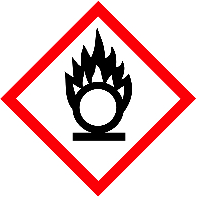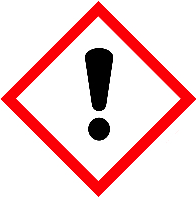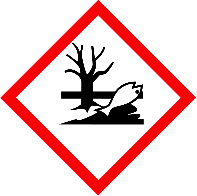Kaliumchloraat.
Technische details en literatuur. Conclusies
Is het veilig om in de klas demonstratieproeven te doen met
kaliumchloraat? Deze vraag was reeds in het voorjaar van 2000 een
heet onderwerp van discussie bij de TOA-discussiegroep.
Drie pagina's over kaliumchloraat in de schoolpraktijk. De forse
verzameling aan feiten en meningen die hierbij naar voren kwam
leverde genoeg materiaal op voor 'Linke Soep'
Deze pagina geeft achtergrond informatie over kaliumchloraat als
gevaarlijke stof.
Klik hier voor de
conclusies.
| Naam: |
Kaliumchloraat |
| Formule: |
KClO3 |
| Smeltpunt: |
356 °C |
| Ontledingstemperatuur: |
400 °C |
| CAS-nummer: |
3811-04-9 |
Grenswaarden:
|
DNEL-inhalatie-lange termijn-systematische
effecten: 5,8 mg/m3
DNEL-huid-lange termijn-systematische effecten: 3,5
mg/kg/dag
*DNEL=Derived No Effect Level
|
| H-zinnen: |
271-(302+332)-411 |
| P-zinnen: |
220-273 |
| Etiket: |

GHS03
|

GHS07 |

GHS09 |
| Reacties: |
Kan explosief ontleden,
vooral bij (minimale) aanwezigheid van organisch
materiaal. |
| Vormt met veel stoffen
explosieve mengsels. |
Hieronder zijn een aantal items verzameld die betrekking hebben
op een aantal aspecten van kaliumchloraat: de ontleedbaarheid,
de ontleedbaarheid bij aanwezigheid van mangaan(VI)oxide
(bruinsteen> de reactiviteit.

- Kaliumchloraat ontleedt gemakkelijk.
- "..De stof ontleedt explosief bij verhitting boven de
400°C onder vorming van giftig en bijtend gas en zuurstof
dat brandbevorderend werkt.."Lit.
1.
- "..HAZARDOUS DECOMPOSITION: Thermal decomposition
products: chlorine, oxides of potassium.."Lit. 3.
- "..kans op explosie door wrijving of stoten van
mengsels, reeds met kleine hoeveelheden organisch
materiaal en geringe ontstekingsenergie..Lit. 1.
- "..REACTIVITY: May decompose on contact with air,
light, moisture, heat or storage and use above room
temperature..
CONDITIONS TO AVOID: Avoid contact with combustible
materials. May ignite or explode on contact with
combustible materials.."Lit. 3.
- "..May ignite or explode on contact with combustible
materials.."Lit. 3.
- "..Although most explosive incidents have involved
mixtures of the chlorate with combustial materials, the
exothermic decomposition of the chlorate to chloride and
oxygen can accelerate to explosion if a sufficient
quantity and powerful enough heating are involved.."Lit. 2.
- "..The more stable sodium chlorate will also explode
under similar conditions.."Lit.
2.
- "..The enthalpy of conversion of potassium chlorate to
either chloride or perchlorate is slight, about ¼ kJ/g,
less than is the case for the sodium salt. During sieving
of the dry chlorate in a store attached to a fuse igniter
plant, a violent explosion of 75 kg of the salt occurred.
It seeems likely that some oxidisable material was
involved in the incident.."Lit.
2.

- Kaliumchloraat is zeer reactief.
- "..De stof is een sterk oxidatiemiddel en reageert
heftig met brandbare en reducerende stoffen. Vormt met
vele organische stoffen en metaalpoeders explosieve
mengsels. Reageert met sterke zuren ondervorming van
chloordioxide.."Lit. 1.
- "..ACIDS (STRONG): May react and form hazardous
chlorine dioxide gas.
ALUMINUM: May explode with heat, percussion, and sometimes
light friction.
AMMONIA: High concentrations of ammonia in air react so
vigorously with potassium chlorate as to be dangerous
CARBON: May explode upon heating, percussion and sometimes
light friction
CHARCOAL: May liberate oxygen and heat explosivily.
CHARCOAL + SULPHUR: Violent explosion wiht friction.
COPPER: May explode with heat, percussion, and sometimes
light friction.
GLUCOSE: Dry mixtures may explode under a hammer-blow
HYDROCARBONS: Mixtures of powdered chlorate and
hydrocarbons explode as violently as nitro compund
explosives.
MAGNESIUM: May explode upon heating, impact, or light
friction.
MANGANESE DIOXIDE: Liberates heat and oxygen explosively
by heat, shock, friction, age, or static electricity.
SUGARS: Impact-sensitive, explosive mixture.
SULFURIC ACID Fire and explosion hazard...."Lit. 3.
- "..Ammonium chloride: Addition of ammonium
chloride to a drum of weed-killer was suspected as the
cause of a violent explosion (involving formation of
ammonium chlorate).."
Fabric: Fabric gloves (wrongly used in place of
impervious plastic gloves) became impregnated during
handling operations and werd subsequently ignited from
cigarette ash.
Sugars: A stoicheiometric mixture with sucrose
ignites at 159°C and has been evaluated as a rocket
propellant. Dry powder mixtures with glucose containing
above 50% of chlorate explode uner a hammer-blow.." Metal,
Wood: Explosions were caused by transportation of
metal casting in woorden kegs previously used to store
potassium chlorate, impact or friction of the metal
causing initiation of the chlorate-impragnated wood.."Lit. 2.

- Mengsels met mangaan(IV)oxide (bruinsteen).
- "..When oxygen is generated in the laboratory by
heating potassium chlorate with manganese dioxide as
decomposition catalyst, the latter must be free of organic
matter or an explosion will occur. The mixture (17 wt of
manganesedioxide, 'oxygen mixture) must ne cautiously
heated at 250°C with a small flame to prevent the
exothermic decomposition reaction becoming violent. Mixing
the components dry with a partially plastic-coated
micro-spatula caused a fire.."Lit.
2.
- "..The oxidation of manganese dioxide to manganate by
solid alkali-chlorate mixtures becomes explosive above
80-90°C at pressures above 19 kbar.."Lit. 2.
- "..MANGANESE DIOXIDE: Liberates heat and oxygen
explosively by heat, shock, friction, age, or static
electricity.."Lit. 3.
CONCLUSIES.
- Bij het werken met kaliumchloraat is een grote
zorgvuldigheid en niet aflatende aandacht van belang.
- Het is gevaarlijk om kaliumchloraat te verhitten. Bij een
temperatuur >= 400°C (boven het smeltpunt) bestaat een kans
op explosieve ontleding, waarbij naast zuurstof en
kaliumchloride, ook het giftige chloorgas en kaliumoxide kan
ontstaan.
- Overlevering leert ons dat mangaan(IV)oxide (bruinsteen) de
ontleding van kaliumchloraat "vertraagt". Bruinsteen zou hier
als katalysator werken, waardoor verlaging van de
activeringsenergie de ontledingstemperatuur beneden het
smeltpunt van kaliumchloraat (368°C) wordt gebracht. Ook in de
literatuur is het werken met bruinsteen bekend. De
mengverhouding die uit de literatuur wordt geadviseerd
bedraagt 17 gewicht% bruinsteeenpoeder. Het verhitten moet met
een klein vlammetje plaatsvinden tot een temperatuur van ca.
250°C. Zowel het kaliumchloraat als het bruinsteenpoeder moet
volkomen vrij zijn van organisch materiaal, omdat anders toch
de kans op explosie bestaat!
- Zelfs een minimale hoeveelheid van een organische
verontreiniging in kaliumchloraat kan een explosie tot gevolg
hebben bij: verwarming, mechanische bewerking, stoten etc. en
laten staan.
- Kaliumchloraat vormt met veel brandbare stoffen en
metaalpoeders explosieve mengsels.
- Binnen het onderwijs is het bekend dat kaliumchloraat de
oorzaak is van ongevallen.
Geciteerde literatuur:
- Chemiekaarten; SDU, Den Haag
- L. Bretherick; "Handbook of Reactive Chemical Hazards"; 1995;
Butterworth/Heineman, Londen; p. 1268)
- Material Safety Data Sheet (MSDS). De MSDS van kaliumchloraat.
 Top
Top
Linke Soep! HOME



